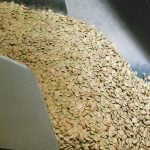Dome wasn’t built in a day. But it is more energy efficient than its traditionally structured counterpart.
“That’s more than you can say about most construction projects,” said Rob Phillips, who builds energy efficient concrete buildings.
Phillips’ 2,400 sq. foot building needs only 3,600 watts of heat to keep winter out.
“A few big light bulbs could do it. Since we built this one (late in 2007) we kept it at six degrees (C) with four 500 watt halogen bulbs,” said Phillips about his concrete dome building, which relies on a small boiler and in-floor, radiant heating.
Read Also

VIDEO: Green Lightning and Nytro Ag win sustainability innovation award
Nytro Ag Corp and Green Lightning recieved an innovation award at Ag in Motion 2025 for the Green Lightning Nitrogen Machine, which converts atmospheric nitrogen into a plant-usable form.
Phillips of Canadian Dome Industries in Saskatoon has built his most recent concrete dome building to highlight the efficiency of the structures.
“To build, they cost about the same, or a little less, than a traditional building. The savings comes in operations, generally half or two-thirds the cost of typical building. Potentially less, depending on the frequency that large doors are opened.”
Phillips said the domes have potential as agricultural buildings.
Due to the reversed design of the buildings, with insulation on the outside and concrete walls on the inside, domed buildings are condensation free and hold energy in and keep weather out.
“Heated shops, sheds, the clear spans mean they can be very flexible and can serve multiple uses. They work for storage of potatoes that need to be kept above freezing or for granular products that need to be dry. They can be set up with (a dropped floor) to keep them safe for chemical storage,” he said.
The floor or walls and roof can support interior structures.
“You can load the roof pretty heavily if you want to hang (interior structures) – 100,000, 200,000 pounds. We can engineer them for more,” he said.
Phillips’ building will be used for paint storage, but he said the structures are popular in ocean port locations for dry bulk fertilizer and grain.
The building has a 25 foot tall ceiling and is 55 feet in diameter, but the buildings can be built up to 300 feet across using a single skin, without cable reinforcements during construction. With a reinforced air-form, any size of building can be constructed, said Phillips.
Construction is fast, due to the building process. A welded vinyl bubble in the shape of an oblate ellipse is attached to a ring beam footing.
It is inflated with air to a pressure of about two inches of water column, measured with a manometer. The interior surface is primed with a paint coating. Seven and one half centimetres of polyurethane foam insulation are sprayed onto the inside of the vinyl dome. Within minutes the foam insulation dries.
A second coat of insulation is applied and rebar hangers are attached to the foam, closing in the building to the weather and making it ready to receive a steel rebar cage.
Shotcrete, pneumatically projected concrete, is then sprayed over the reinforcing steel.
In the case of the 2,400 sq. foot building, the dome is 13.75 cm thick at the base and thins to 10 cm at the top.
“On a warm day we can put up (2.5 cm) of concrete twice a day. If it’s cold out it might only happen once a day,” he said of the three to four week construction time.
Rather than a hemisphere shape, the buildings are an oblate ellipse. This reduces overall height of the dome and provides straighter walls that don’t give up usable floor area to arched sidewalls.
The domes can and often are built on top of pony or stem walls, further enhancing usable floor and wall space. Pony walls can be constructed to accept large side loads of bulk materials.
Doors, windows and larger features that are placed in the walls of the dome should be engineered into the design, said Phillips. Smaller holes for utilities can be cut with concrete tools.
The outer skins can be painted, however the UV protected vinyl is designed to last without maintenance.
Interior concrete surfaces can be painted with latex paints.
Phillips said beyond commercial buildings the company has used the design for churches and homes.
He said the construction process is nearly waste free.
“We didn’t have a full one-ton (truck) load left over when we finished this building,” he said.














